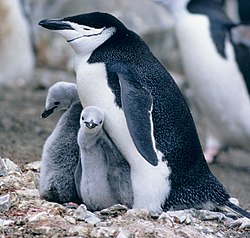This is an old revision of this page, as edited by 71.194.104.68 (talk) at 03:07, 15 November 2006 (→Anatomy). The present address (URL) is a permanent link to this revision, which may differ significantly from the current revision.
Revision as of 03:07, 15 November 2006 by 71.194.104.68 (talk) (→Anatomy)(diff) ← Previous revision | Latest revision (diff) | Newer revision → (diff) For other uses, see Penguin (disambiguation).
| Penguins Temporal range: Paleocene-Recent | |
|---|---|

| |
| Chinstrap Penguin, Pygoscelis antarctica | |
| Scientific classification | |
| Kingdom: | Animalia |
| Phylum: | Chordata |
| Class: | Aves |
| Order: | Sphenisciformes Sharpe, 1891 |
| Family: | Spheniscidae Bonaparte, 1831 |
| Modern Genera | |
| |
Penguins (order Sphenisciformes, family Spheniscidae) are an order of aquatic, flightless birds living exclusively in the Southern Hemisphere.
Species and habitats
The number of penguin species has been and still is a matter of debate. The numbers of penguin species listed in the literature varies between 16 and 19 species. Some sources consider the White-Flippered Penguin a separate Eudyptula species, although today it is generally considered a subspecies of the Little Penguin (e.g. Williams, 1995; Davis & Renner, 2003). Similarly, it is still unclear whether the Royal Penguin is merely a color morph of the Macaroni penguin. Also possibly eligible to be treated as a separate species is the Northern population of Rockhopper penguins (Davis & Renner, 2003). Although all penguin species are native to the southern hemisphere, they are not, contrary to popular belief, found only in cold climates, such as Antarctica. In fact, only a few species of penguin actually live so far south. Three species live in the tropics; one lives as far north as the Galápagos Islands (the Galápagos Penguin).
The largest living species is the Emperor Penguin (Aptenodytes forsteri): adults average about 1.1 m (3 ft 7 in) tall and weigh 35 kg (75 lb) or more. The smallest penguin species is the Little Blue Penguin (also known as the Fairy Penguin), which stands around 40 cm tall (16 in) and weighs 1 kg (2.2 lb). Generally larger penguins retain heat better, and thus inhabit colder regions, while smaller penguins are found in temperate or even tropical climates (see also Bergmann's Rule). Some prehistoric species attained enormous sizes, becoming as high as an adult human; see below for more.
Most penguins feed on krill, fish, squid, and other forms of sealife caught while swimming underwater. They spend half of their life on land and half in the oceans.
When mothers lose a chick, they sometimes attempt to steal another mother's chick, usually unsuccessfully as other females in the vicinity assist the defending mother in keeping her chick.
Penguins seem to have no fear of humans and have approached groups of explorers without hesitation. This is probably on account of there being no land predators in Antarctica or the nearby offshore islands that prey on or attack penguins. Instead, penguins are at risk at sea from such predators as the leopard seal.
COCK BALLS
Mating habits
Some penguins mate for life, while others for just one season. They generally raise a small brood, and the parents cooperate in caring for the clutch and for the young. During the cold season on the other hand the mates separate for several months to protect the egg. The male stays with the egg and keeps it warm, and the female goes out to sea and finds food so that when it comes home, the baby will have food to eat. Once the female comes back, they switch.
Male bonding behaviour
In early February 2004 the New York Times reported a male pair of Chinstrap penguins in the Central Park Zoo in New York City were partnered, and when given an egg which needed incubation, successfully hatched it. Other penguins in New York have also been reported to be forming same-sex pairs.
This was the basis for the children's picture book And Tango Makes Three. The couple about whom the book was based, Roy and Silo, would see further interesting developments in their relationship when in September 2005, Silo left Roy for a female penguin, only to come back to Roy in a few weeks.
Zoos in Japan and Germany have also documented male penguin couples. The couples have been shown to build nests together and use a stone to replace an egg in the nest. Researchers at Rikkyo University in Tokyo, found twenty such pairs at sixteen major aquariums and zoos in Japan. Bremerhaven Zoo in Germany attempted to break up the male couples by importing female penguins from Sweden and separating the male couples; they were unsuccessful. The zoo director stated the relationships were too strong between the older couples.
Name
Penguin is thought by some to derive from the Welsh words pen (head) and gwyn (white), applied to the Great Auk, which had a conspicuous white patch between the bill and the eye (although its head was black), or from an island off Newfoundland known as "White Head" due to a large white rock. This may be, however, a false etymology created by Dr. John Dee in his book on Prince Madoc of Wales, supposedly one of the discoverers of America. By this Dee hoped to cement Queen Elizabeth I's claim, as a Tudor, to the New World. Penguins live nowhere near Newfoundland, nor do they generally have white heads, however Great Auks did look remarkably like penguins. According to another theory, the original name was pen-wing, with reference to the rudimentary wings of both Great Auks and penguins. A third theory is that penguin comes from the Latin pinguis (fat). This has added credibility because in two other Germanic languages, Dutch 'pinguïn' and German, 'Pinguin' both have the 'i' vowel too. While it has been replaced by an 'e' in the English spelling, it can still be heard. By simply looking at the word's pronunciation and comparing that to the Dutch and German words, one could assume a common Latin root - after the first Germanic sound shift (500-200 BC) that makes a PIE 'p' into a 'f', of course. However, a Welsh 'i' is often mutated to an 'e' in the English language so the Welsh origin is still arguable..
Penguins in popular culture

Penguins are popular around the world primarily for their unusually upright, waddling pace and (compared to other birds) lack of fear towards humans. Their striking black and white plumage is often likened to a tuxedo suit and generates humorous remarks about the bird being "well dressed".
Perhaps in reaction to this cutesy stereotype, fictional penguins are occasionally presented as grouchy or even sinister. The popular Sanrio character Badtz Maru is an example, being cute yet somewhat surly. One of the best known penguins in childrens' TV is Pingu, characterised by his red scarf and bundle on a stick over his shoulder. The 1960s television cartoon character Tennessee Tuxedo would often escape the confines of his zoo with his partner, Chumley the walrus. Also, the webcomic Fluble features an enormous penguin conspiracy run by numerous diabolical, if often inept, penguins. In the children's movie Madagascar, the penguins are cast as spies. In the animated series "Wallace and Gromit" a penguin called Feathers McGraw disguises himself as a chicken with a red rubber glove.In the animated "Toy Story 2" a rubber penguin named Wheezy also featured-and once again was a sweet and friendly character. Penguins are often portrayed as friendly and smart as well. Another example is in the anime Neon Genesis Evangelion, which features a warm-water hot springs penguin named Pen Pen. Tux the penguin is the official mascot for Linux. Also, in Avatar: The Last Airbender, a popular sport is penguin sledding, which is catching a penguin and using it like a tobbogan. There was also a film that came out in 1988 called "Scamper The Penguin," directed by G.A. Sokoljishij and Jim Terry, featuring Virginia Masters, David Miles Monson, and others as the voices of the animated characters who execute an elaborate escape plan. There is also the classic Woody the Woodpecker show, with Chilly Willy.
The Penguin is also the name of a villain in the comic series Batman and its TV show and movie spinoffs, and is usually seen wearing a tuxedo type outfit in order to fit the name.
Opus, a character from the Comic strips Bloom County, Outland, and Opus was a popular penguin from the 80's on, typically seen with a rather un-penguinlike nose.
Penguins also appear regularly in Steve Bell's "If" comic strip in England's Guardian newspaper, wherein they tend to be somewhat anarchic and poorly behaved (by human standards).
On 4th April 2004, at the New York Bronx Zoo R Kelly made a public appearance as part of a publicity stunt to raise awareness for the Falkland Conservation, dressed as a penguin.
The documentary March of the Penguins (2005) details a year in the life of a colony of Emperor Penguins mating, giving birth, and hunting for food in the harsh continent of Antarctica. It won the 2005 Academy Award for Documentary Feature.
The old Budweiser ice commercials starred a Penguin, with the catchphrase "Doo bee doobee dooo," signaling his arrival, and the eventual stealing of the Bud ice.
The Little America hotels used a penguin as their logo for many years.
In the upcoming Pokemon Diamond and Pearl video game for the Nintendo DS, the water starter is a penguin.
Penguins and polar bears
Despite what commercials and other sources may show, the likelihood of a meeting between a penguin and a polar bear without human intervention is vanishingly small. This is because the two species are found on opposite hemispheres. Polar bears inhabit the northern hemisphere, while penguins mainly inhabit the southern hemisphere. This is a misconception that is fueled by popular culture such as movies and television. A prominent example of this takes place in a holiday 2005 ad campaign by Coca-Cola featuring the partying penguins and the polar bears watching from afar.
External links
- penguinpage.net - Weblog covering ongoing research in NZ penguins
- Live Penguin Webcam
- Penguin information on 70South
- Gentoo penguin webcam from the Antarctic
- Information about penguins at pinguins.info
- PBS Nature: The World of Penguins
- Integrated Taxonomic Information System
- Seaworld Penguin Information
- Penguin Weblog
- Pictures Penguins
- Penguin Videos on the Internet Bird Collection
- Penguin World
References
- "Columbia News Service: June 10, 2002: They're in love. They're gay. They're penguins... And they're not alone". Retrieved 2006-07-21.
- "365gay.com: Gay Penguins Resist 'Aversion Therapy'". Retrieved 2006-07-21.
- "Bud Ice ad on YouTube". Retrieved 2006-07-21.
- Acosta Hospitaleche, Carolina (2004): Los pingüinos (Aves, Sphenisciformes) fósiles de Patagonia. Sistemática, biogeografía y evolución. Doctoral thesis, Department of Natural Sciences and Museum, Universidad Nacional de La Plata. La Plata, Argentina. PDF fulltext
- Davis; Lloyd S.; Renner; M. (1995). Penguins . London: T & A D Poyser. ISBN 0-7136-6550-5.
- Marples, B. J. (1962): Observations on the history of penguins. In: Leeper, G. W. (ed.), The evolution of living organisms. Melbourne, Melbourne University Press: 408-416.
- Mayr, G. (2005): Tertiary plotopterids (Aves, Plotopteridae) and a novel hypothesis on the phylogenetic relationships of penguins (Spheniscidae). Journal of Zoological Systematics and Evolutionary Research 43(1): 61-71. DOI:doi:10.1111/j.1439-0469.2004.00291.x PDF fulltext
- Williams; Tony D. (1995). The Penguins - Spheniscidae . Oxford: Oxford University Press. ISBN 0-19-854667-X.
Gallery
-
 Adelie penguin in Antarctica
Adelie penguin in Antarctica
- African Penguin African Penguin
-
 Chinstrap Penguin hunting for krill
Chinstrap Penguin hunting for krill
-
 Humboldt Penguin at the Milwaukee County Zoological Gardens
Humboldt Penguin at the Milwaukee County Zoological Gardens
-
 Magellanic Penguin
Magellanic Penguin
-
 Gentoo Penguin
Gentoo Penguin
- Little Penguin - also called "Fairy Penguin" Little Penguin - also called "Fairy Penguin"
-
 Emperor Penguins
Emperor Penguins
- Gentoo Penguin at polish Arctowski base Gentoo Penguin at polish Arctowski base
Template:Link FA Template:Link FA
Categories: